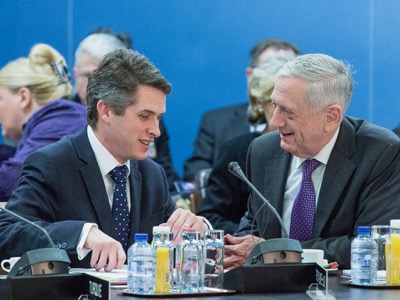
There is a party that, even if it does not appear, takes part in the Italian elections: the NATO Party. It is formed by a transversal majority, that explicitly or tacitly supports Italy’s membership of the Great Alliance under U.S. command.
This explains why, at the height of the electoral campaign, the main parties tacitly accepted the additional commitments undertaken by the government in the meeting of 29 Nato ministers of Defence (for Italy Roberta Pinotti), on 14-15 February in Brussels.
The ministers first participated in the Nato Nuclear Planning Group, chaired by the United States, whose decisions are always top secret.
Then the ministers met at the level of North Atlantic Council. Just two hours later, they announced important decisions (already taken elsewhere) to "modernise the NATO Com-mand Structure, the backbone of our Alliance".
A new Joint Force Command for the Atlantic will be set up, probably located in the United States, in order to "protect sea lines of communication between North America and Europe". Thus they invented the scenario of Russian submarines that could sink merchant ships on transatlantic routes.
A new Command for logistics will be set up, probably located in Germany, to "improve the movement in Europe of troops and equipment essential to our collective defense". Thus they invented the scenario of a NATO forced to defend itself from an aggressive Russia. On the contrary, it is NATO that aggressively deploys its military forces along the border with Russia. Additional land component commands will be established in Europe to "further improve coordination and rapid response for our forces".
NATO will also set up a new Cyber Operations Centre to "further strengthen our defenses". It will be located at the headquarters of Mons (Belgium), headed by the Supreme Allied Commander in Europe, who always is a U.S. General appointed by the President of the United States.
The ministers confirmed their commitment to increase military spending. Over the last three years, the European allies and Canada ncreased it by a total of $ 46 billion, but it is just the beginning. The goal is that every member country reaches at least 2% of the GDP (the US spend 4%), so as to have "more cash and therefore more military capabilities".
The European countries that have so far reached and exceeded this quota are: Greece (2.32%), Estonia, Great Britain, Romania, Poland. The military spending of the European Union must be complementary to that of NATO. This was reiterated in a meeting with the EU foreign representative Federica Mogherini
Minister Pinotti confirmed that "Italy, respecting U.S. demand, has begun to increase spending for Defence" and that "we will continue on this road that is a road of responsibility".
The way is therefore traced. But this is not talked about in the electoral campaign. While on Italy’s membership of the European Union the main parties have different positions, on the belonging of Italy to NATO are practically unanimous. This distorts the whole scenario.
We cannot discuss about the European Union while ignoring that 21 out of the 27 EU countries (after Brexit), with about 90% of the population of the Union, are members of NATO under U.S. command.
We cannot ignore the political and military consequences - at the same time economic, social and cultural consequeces - of the fact that NATO is turning Europe into a battlefield against Russia, depicted as a threatening enemy: the new "empire of evil" attacking "the greatest democracy in the world" from the inside with its army of trolls.

 Articles by this author
Articles by this author Send a message
Send a message











Stay In Touch
Follow us on social networks
Subscribe to weekly newsletter